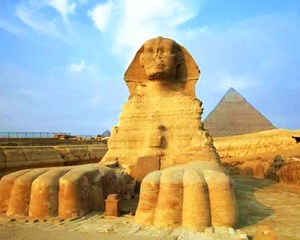In front of the Pyramid of Chephrenes stands the great Sphinx, —the hugest marvel of sculpture which the world has ever seen. For centuries this colossal wonder lay almost sub merged beneath the sand-drift of the desert. Caviglia undertook the laborious task of uncovering it; in the course of which he made some important discoveries, tending to show that there was anciently a temple on the area beneath the stony gaze of the colossal countenance, and an altar upon which sacrifices were offered. The features are Nubian, or rather ancient Egyptian, and their expression is strikingly calm and benignant.

"There was something," says Stanley, "stupendous in the sight of that enormous head—its vast projecting wig, its great ears, its open eyes, the red colour still visible on its cheeks, the immense projection of the lower part of its face. Yet what must it have been when on its head there was the royal helmet of Egypt, on its chin the royal beard; when the stone pavement by which man approached the Pyramids ran up between its paws; when immediately under its breast an altar stood, from which the smoke went up into the gigantic nostrils of that nose, now vanished from the face, never to be conceived again! All this is known with certainty from the remains which actually exist deep under the sand on which you stand, as you look up from a distance into the broken but still expressive features."—In regard to the Sphinx we may add, that so continuous is the drift of sand from the desert, that nearly all those portions of the figure which modern investigators have at different times laid bare have been again covered.












